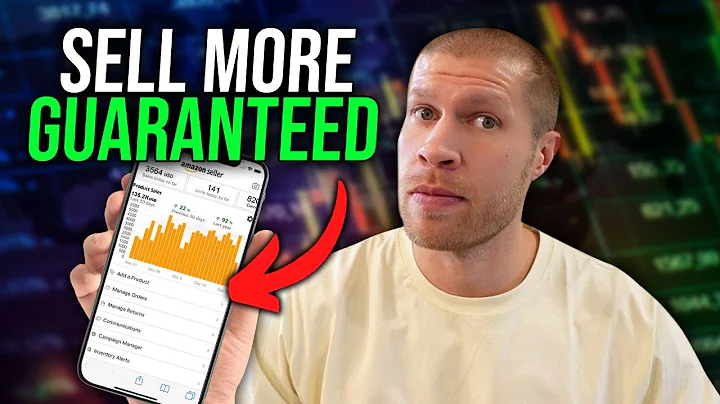From Debt to Success: How I Made $1.2M Dropshipping as a Beginner
Table of Contents:
- Introduction: From Debt to Success in Drop Shipping
- My Journey: University, Jewelry Brand, and the Transition to Drop Shipping
- Choosing a Winning Brand: Niche Selection and Specialization
- Finding a Winning Product: Spying on Competitor Ads and Tracking Sales
- Testing and Advertising Platforms: Facebook, Google, TikTok, Pinterest
- Scaling and Growing the Business: Content Creation, Website Improvements, and Hiring
- Selling the Business: Longevity, Profitability, and Building a Solid Foundation
- Conclusion: Lessons Learned and Future Opportunities
Introduction: From Debt to Success in Drop Shipping
In this article, I will share my journey from being a university student in debt to achieving tremendous success in the world of drop shipping. I will take you through the steps I followed to create a sustainable and profitable drop shipping brand. From choosing the right niche and product to scaling and eventually selling the business, I will provide insights and strategies that can help you achieve similar results. If you are a complete beginner or looking to enhance your drop shipping business, this article is for you. Let's dive in!
My Journey: University, Jewelry Brand, and the Transition to Drop Shipping
Four years ago, I found myself drowning in debt while studying at university. I was working at Domino's and living at my friend's house for free. I knew that I didn't want to settle for a regular job, so I started exploring alternative ways to make money. That's when I stumbled upon drop shipping. It seemed like a promising opportunity, and I decided to give it a shot.
Before finding success in drop shipping, I had dabbled in running a jewelry brand during my university years. Although the brand didn't generate substantial profits, it taught me valuable skills such as website development, creating ads, branding products, and establishing relationships with suppliers.
After completing university, I was unsure of my next steps, especially with the onset of lockdowns limiting job opportunities. It was during this time that a friend suggested I explore drop shipping as a way to make money remotely. I decided to take the leap and focus my efforts on drop shipping.
Choosing a Winning Brand: Niche Selection and Specialization
One of the key challenges people face in drop shipping is choosing a winning brand in a saturated market. However, it's essential to understand that there are specific strategies that can help you stand out and succeed. It begins with selecting a niche and specializing within that niche.
I'll use the fashion industry as an example to explain this concept further. Fashion is a billion-dollar industry, but diving into the broader market may not yield immediate success. Instead, you need to identify a sub-niche within the fashion industry, such as preppy clothing, high fashion, minimalist, streetwear, vintage, or retro.
By selecting a specific sub-niche, you position yourself as a specialist within that segment. Customers are more likely to purchase from a brand that focuses on their specific interests and needs. For example, if you choose to specialize in jackets within the women's fashion niche, you become the go-to brand for women seeking high-quality jackets. This specialization sets you apart and increases your chances of success.
Finding a Winning Product: Spying on Competitor Ads and Tracking Sales
Once you have chosen your niche and sub-niche, the next crucial step is finding a winning product. Fortunately, in today's digital age, gathering data on competitor ads and sales has become more accessible than ever before.
To find profitable products, you can utilize tools like Minier for ad spying and dropship.io for tracking sales. By analyzing competitor ads on platforms like Facebook, you can identify which products are performing well and generating significant engagement. This indicates a potential opportunity for you to enter the market.
For example, if you spot a successful ad for dog multivitamins in the US market, you can explore the possibility of selling a similar product in a different country or targeting a different audience. Tools like Dropship.io can help you track the sales of competitors and ascertain the profitability of a particular product.
It's important to note that once you find a product with potential, you'll need to secure a reliable supplier or manufacturer to ensure consistent product quality and fulfillment. Platforms like AliExpress can provide options for white-labeling or dropshipping products. Doing thorough research and due diligence is crucial at this stage.
Testing and Advertising Platforms: Facebook, Google, TikTok, Pinterest
Testing your products on various advertising platforms is essential to determine the most effective way to reach your target audience. Facebook and Instagram are usually reliable platforms for testing products due to their extensive user base. These platforms allow you to gather data and assess the viability of your product in the market.
Google ads are valuable for products that are actively searched for by potential customers. If your product falls into this category, leveraging Google's search engine optimization (SEO) capabilities can yield favorable results.
Platforms like TikTok and Pinterest can be effective for reaching specific demographics or leveraging visual content. However, it's important to consider factors such as content fatigue and audience suitability for your product.
As a beginner, focusing on cash flow is crucial, so it's recommended to choose one or two platforms initially and scale up gradually as you gather more data and optimize your advertising campaigns.
Scaling and Growing the Business: Content Creation, Website Improvements, and Hiring
Once you have found a winning product and validated its profitability, the next step is scaling and growing your business. To do this effectively, consider the following strategies:
-
Content Creation: Focus on creating engaging and valuable content across various social media platforms. Share product information, tutorials, and lifestyle content to connect with your target audience and build a loyal customer base.
-
Website Improvements: Continuously improve your website's design, functionality, and user experience. Optimize product descriptions, add customer reviews, and implement strategies to increase conversions and reduce bounce rates.
-
Hiring: As your business grows, consider hiring virtual assistants or employees to handle customer support, content creation, and advertising on different platforms. Delegating tasks will help free up your time and allow you to focus on strategic decision-making and scaling the business.
-
Expanding Advertising Platforms: Once you have established a solid presence on one platform, explore opportunities to expand your advertising efforts to other platforms like Google ads, Pinterest, or TikTok. This diversification helps you reach a wider audience and increase your overall sales and revenue.
By implementing these growth strategies, you can effectively scale your drop shipping business and create a sustainable and profitable venture.
Selling the Business: Longevity, Profitability, and Building a Solid Foundation
Selling a drop shipping business can be challenging due to the perception of limited longevity. However, by focusing on building a solid foundation, profitability, and longevity, you can position your business for a successful sale.
To increase the chances of selling your business, consider the following factors:
-
Longevity: Potential buyers are more likely to be interested in businesses that have been operating for at least two years. Establishing a track record and demonstrating sustainability over time will attract more potential buyers.
-
Profitability: The value of your business is often calculated based on its annual profits. Focus on maximizing profitability by optimizing your operations, reducing costs, and increasing sales. A profitable business is more appealing to buyers.
-
Building a Solid Team: Hiring and training a competent team is vital to the success of your business and its overall value. Delegate tasks, establish efficient processes, and build a team that can effectively run the business independently.
-
Systemized Operations: Develop standardized operating procedures for each aspect of your business, from customer support to order fulfillment. Having well-documented processes in place increases the value of your business and makes it easier to transfer ownership.
By focusing on these factors and creating a business that is profitable, sustainable, and scalable, you position yourself for a successful exit and a potentially significant return on your investment.
Conclusion: Lessons Learned and Future Opportunities
In conclusion, my journey from student debt to drop shipping success has taught me valuable lessons and strategies that can be applied by anyone looking to achieve similar results. By choosing the right niche, finding a winning product, testing on various platforms, scaling the business, and building a solid foundation, you can create a profitable drop shipping venture.
It's important to be adaptable and keep up with industry trends and changes. Explore new opportunities, continuously improve your processes, and stay ahead of the competition. The drop shipping world is dynamic, and there will always be new ways to innovate and grow your business.
Remember, success in drop shipping requires hard work, dedication, and a willingness to learn from both successes and failures. Embrace the challenges, persevere through setbacks, and keep an eye out for new opportunities. With the right mindset and strategies, you can turn your drop shipping dreams into a reality.










